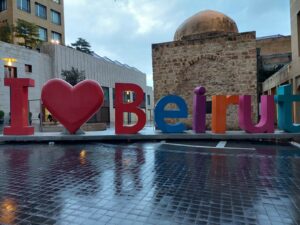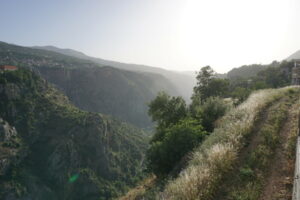Lebanon: history, culture and nature
Vibrant, cosmopolitan and occupying a unique niche – both geographically and historically – between the Christian West and the Muslim East, the Republic of Lebanon is a fascinating crossroads of cultures and a tourism destination not quite like any other.
One of the smallest sovereign nations in the world, Lebanon is a land of stunning natural beauty, architecturally eclectic settlements, mouth-watering cuisine and famously hospitable natives.

Lebanon
Name: Republic of Lebanon
Capital: Beirut
Population: 5.2 million
Surface area: 10,452 km²
Language: Arabic, French
Neighboring countries: Israel, Syria






Lebanon is a country of diversity. Incredible food, beautiful nature, beaches and a rich history makes it a perfect destination.
Davide (italy)
Beirut
Beirut is one of the world’s oldest continuously inhabited settlements and a Middle East hot spot for cuisine, nightlife, museums and culture, the Lebanese capital was named by the New York Times as the world’s most desirable destination in 2009, and continues to go from strength to strength. Be sure to check out the Martyrs’ Monument and the city’s dynamic street art scene!
Baalbek
An architectural wonder showcasing Lebanon’s eclectic cultural legacy, Baalbek is renowned for its extraordinarily well-preserved Roman temples of Bacchus and Jupiter. Despite being rocked by devastating earthquakes in the 18th Century, the temple complex remains one of the finest examples of extant Roman architecture in the world.
Qadisha Valley
Emblematic of Lebanon’s historic status as a haven for refugees of all colors and creeds, Qadisha Valley (“Holy Valley”) is one of the country’s most fascinating destinations, both geographically and culturally. The valley is home to ancient cedar trees – prized throughout the ancient world as a building material – and was long a destination for both Christians fleeing persecution and Muslim holy men seeking solitude. Dotted with countless natural caves and unique Christian monasteries, the valley has no shortage of nooks and crannies for the intrepid explorer.
Bsharre, a town located near the valley, is one of Lebanon’s most visually stunning towns and, inevitably, one of its biggest tourist draws. There is no end of attractions in the town’s vicinity, including the “Cedars of the Gods” forest and the famous Cedars Ski Resort. The town is known for its strong Christian tradition and distinctive Aramaic-influenced dialect.
Tripoli
Not to be confused with its namesake in Libya, “Levantine Tripoli” (as it’s known in the Arab world) is renowned for its distinctive skyline and its various historic buildings. From the Citadel of Raymond de Saint-Gilles to the iconic Ottoman clock tower, you’ll never run out of photo opportunities in this beautiful coastal city. Be sure to stop by one of the hammans – Middle Eastern bathhouses – to soak in steaming-hot water after a day of sightseeing!
Noted in antiquity for its string of coastal trading hubs, Lebanon was renowned for its strong mercantile tradition and was known as Phoenicia. The Ancient Phoenicians were heavily involved in trading Arabian spices to the Greeks, and it was by this mechanism that the Greeks were introduced to the 24-letter phonetic alphabet of the Phoenicians. This would later form the basis for the Greek alphabet, and its simple phonetic nature and ease of use would shatter the hitherto-elitist stranglehold on literacy.
Passing through various hands throughout classical antiquity (The Achaemenid, Macedonian and Seleucid Empires, to name a few), Lebanon eventually became a Christian stronghold from the first century CE.
The early days
During the 7th Century CE Lebanon fell under the control of Muslim Arabs shortly after the death of Muhammad. The country remained largely Muslim (with the exception of a period of Christian rule during the 11th Century crusades), passing into Ottoman rule in the 13th Century.
No Middle Eastern country was complete without European meddling in the 19th Century, of course; the region was wracked by British-induced rebellion against the Ottomans, and endless conflicts and massacres marked a troubled period of Lebanese history.
Modern times
Following the fall of the Ottoman Empire at the conclusion of World War I, the British and French divided the region up among themselves, with the French assuming stewardship of the newly-created state of Greater Lebanon. Lebanon finally assumed independence and complete autonomy from foreign powers, after a period of almost two millennia, on November 22nd, 1943.
In the following decades, Lebanon enjoyed a period of prosperity, becoming a tourist hotspot in the 1960s, and Beirut became renowned as the “Paris of the Middle East”. The country’s proximity made it a refuge of choice for Palestinians fleeing conflict with Israel. One of those Palestinians was Yasser Arafat who, along with his Palestinian Liberation Organisation, used southern Lebanon as a staging ground for attacks against Israel. This would result in retaliatory strikes against Lebanon from Israel and, eventually, the Lebanese Civil War.
Though not quite free and clear of calamities, Lebanon remains an attractive choice of destination for any traveler curious about this vibrant Middle Eastern country.